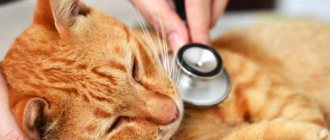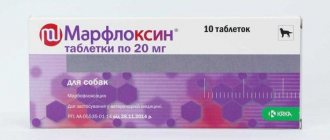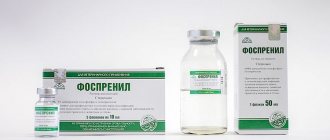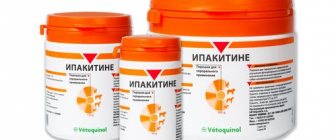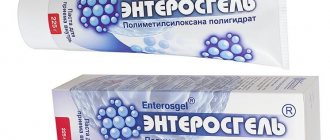Stomorgyl for dogs - instructions for use
For the treatment of infections of bacterial etiology in dogs and cats
Instructions for use of the drug Stomorgyl 2, 10 and 20 for the treatment of infections of bacterial etiology in dogs and cats (developer organization, France)
I. General information Trade name of the drug: Stomorgyl 2, 10, 20 (Stomorgyl 2, 10, 20). International nonproprietary name: spiramycin and metronidazole.
Dosage form: tablets. The drug as active ingredients, depending on the dosage, respectively contains:
- Stomorgyl 2 (120 mg tablet) - spiramycin 150,000 IU and metronidazole 25 mg;
- Stomorgyl 10 (tablet weighing 600 mg) - spiramycin 750,000 IU and metronidazole 125 mg;
- Stomorgil 20 (tablet weighing 1200 mg) - spiramycin 1,500,000 IU and metronidazole 250 mg;
as well as auxiliary components: aluminum hydroxide - 4%, sorbitol - 2%, white dextrin - 0.15%, gelatin - 0.25%, magnesium stearate - 1% and starch - up to 100%.
The drug is released in blisters packed in cardboard boxes.
Store the drug in the manufacturer's sealed packaging, separate from food and feed, in a dry place, protected from direct sunlight, at a temperature from 0°C to 25°C. The shelf life of the medicinal product, subject to storage conditions, is 3 years from the date of production. It is prohibited to use Stomorgil 2, 10, 20 after the expiration date.
Stomorgyl 2, 10, 20 should be stored out of the reach of children.
Unused medicinal product is disposed of in accordance with legal requirements.
II. Pharmacological properties Stomorgil 2, 10, 20 refers to combined antibacterial drugs. Thanks to the combination of its active components, it has a wide spectrum of action against gram-positive and gram-negative microorganisms.
Spiramycin is an antibiotic of the macrolide group; it has bacteriostatic activity, reversibly binding to the 50S ribosomal subunit, and inhibits protein synthesis in the microbial cell. Active against gram-positive and some gram-negative microorganisms, including Staphylococcus spp., Streptococcus spp., Clostridium spp., Corynebacterium, Actinomyces, Bacteroides and Mycoplasma spp.
When administered orally, it is quickly adsorbed in the gastrointestinal tract and diffuses well into biological fluids (including saliva), organs and tissues. The maximum concentration of spiramycin in blood plasma is observed after 4-6 hours, in saliva - after 4-8 hours.
Metronidazole is an antiprotozoal agent from the nitro-5-imidazole group. Active against anaerobic microorganisms, including Bacteroides spp., Clostridium spp., Fusobacterium, suppresses the development of protozoa, including balantidia, trichomonas, lamblia and amoebae. After oral administration, metronidazole is rapidly and almost completely absorbed from the gastrointestinal tract, reaching maximum concentrations in plasma and saliva after 1 hour. Metabolism occurs in the liver by oxidation and binding to glucuronic acid.
Stomorgyl is used to treat infections caused by staphylococcus, streptococcus, and clostridia. Stomorgyl is also effective in the treatment of mycoplasmosis in cats and dogs, trichomoniasis, amebiasis, giardiasis and other protozoal diseases.
The active components of the drug are excreted from the body mainly with urine and partly with feces, and in lactating animals also with milk.
In terms of the degree of impact on the body, Stomorgyl 2, 10, 20 belongs to moderately dangerous substances (hazard class 3 according to GOST 12.1.007-76), in recommended doses it does not have a sensitizing, teratogenic or embryotoxic effect.
III. Directions for use Stomorgyl 2, 10, 20 is prescribed to dogs and cats for the treatment of bacterial infections caused by microorganisms sensitive to metronidazole and spiramycin, and primarily infections of the oral cavity, including periodontal diseases, stomatitis, gingivitis and pyorrhea.
A contraindication for use is the animal’s hypersensitivity to the components of the drug (including a history of it). Animals with severe heart, kidney and liver diseases should use the drug with caution under the supervision of a veterinarian.
Stomorgyl 2, 10, 20 is administered to dogs and cats individually orally once a day at a dose of 75,000 IU of spiramycin and 12.5 mg of metronidazole (active ingredients) per 1 kg of animal weight, based on:
- 1 tablet of Stomorgil 2 - per 2 kg of animal weight;
- 1 tablet of Stomorgil 10 - per 10 kg of animal weight;
- 1 tablet of Stomorgil 20 - per 20 kg of animal weight.
Pharmacological properties
The French-made drug Stomorgil is intended to combat microorganisms that cause inflammation in the oral cavity of a pet. The drug is effective at almost any stage of the disease, but it is mainly prescribed in the early stages of the disease and in critical situations.
- chlamydia;
- meningococci;
- Helicobacter pylori;
- Trichomonas;
- mycoplasma;
- clostridia.
Metronidazole is a powerful antibiotic that can kill even the most dangerous bacteria. Its mechanism of action is based on blocking the respiration of anaerobic microorganisms. Spiramycin is an antibiotic of natural origin that gently copes with toxoplasma, trichomonas and staphylococci, while acting carefully and protecting the body from active bacterial damage. The active work of two antibiotics helps stop the development and reproduction of dangerous bacteria.
https://www.youtube.com/watch?v=7ErilJsTdmo
The drug Stomorgyl is intended to destroy microorganisms that cause inflammation in the oral cavity of pets. Stomorgil for cats is effective at any stage of the disease, but more often it is prescribed at the very beginning of the development of pathology or during an exacerbation. Spiramycin and Metronidazole, which are part of Stomorgil, are powerful antibiotics.
They destroy most bacteria, both gram-negative and gram-positive. These include: clostridia; chlamydia; meningococci; Helicobacter pylori; trichomonas; mycoplasma. The pharmacological action of Stomorgil is due to the main components of the drug. Metronidazole is an antibiotic that kills all the most dangerous bacteria.
Composition and action
These are pink-coated tablets intended for oral use. They are packaged in blisters of 10 pieces. The cardboard package contains two such blisters and instructions for use.
The high effectiveness of the drug is due to the combination of two active components:
- Spiramycin is an antibiotic of the macrolide group. Blocks protein synthesis in streptococci, staphylococci, listeria, clostridia, chlamydia, and other types of harmful bacteria. Capable of destroying mycoplasmas. It accumulates not only in the blood, but also in saliva. 4-8 hours after taking the medication, the concentration of spiramycin in the blood reaches its maximum value.
- Metronidazole is an antiprotozoal agent. Prevents the reproduction and development of the simplest harmful organisms, including lamblia, amoebas, trichomonas, etc. The substance is absorbed in the gastrointestinal tract and reaches its maximum concentration in the blood in just an hour and a half. Partially decomposed in the liver. Both components are mostly excreted in the urine, and during lactation, partially in milk.
In the manufacture of the medicine, auxiliary components are also used:
- magnesium stearate;
- sorbitol;
- white dextrin;
- starch;
- aluminum hydroxide;
- gelatin.
For convenient use and correct dosage calculation, the manufacturer produces tablets in three versions:
- Stomorgil 2 for puppies and small breed dogs;
- Stomorgil 10 for pets of medium breeds;
- Stomorgil 20 for large breed animals.
When purchasing, be careful, since the difference lies in the concentration of active substances. When using more concentrated tablets for small dogs, it will be difficult to calculate the correct dose and prevent overdose.
general description
Stomorgyl is an antibacterial agent in tablet form. The small tablets are yellow in color. In addition, each tablet has a groove that allows it to be divided into two equal parts. Its presence is especially important for owners of small cats, since antibiotic doses are calculated based on weight. Blisters are used to package tablets.
Depending on the concentration of the active components, the drug is produced in three versions - Stomorgyl 2, 10 and 20. For cats, the medicine with the lowest concentration is usually used. This makes it easier to calculate the correct dose and prevent an overdose, the consequences of which will negatively affect the animal’s well-being and general health. For large cats and cats, Stomorgyl 10 is sometimes used.
Note! The drug Stomorgyl 20 is intended for large dogs; it is prohibited for use in cats. It is not possible to calculate the correct dose
No special conditions need to be observed during storage. Without fear that the drug will lose its pharmacological properties, it can be placed in a veterinary medicine cabinet or placed on the top shelf of a cabinet. The main thing is that it is away from the sun's rays, and the air temperature is positive, but does not exceed 25 degrees Celsius.
Indications for use
Stomorgyl is prescribed to dogs as part of complex therapy for diseases of the oral cavity:
- with gingivitis;
- with stomatitis;
- with periodontitis;
- with pyorrhea, etc.
It can also be used in the treatment of diseases caused by bacteria, protozoa and fungi that are sensitive to spiramycin and metronidazole. Usually the drug is prescribed for acute or subacute course of the pathology.
According to the classification according to GOST 1976, the drug is classified as a moderately hazardous substance. If the recommended dose is not exceeded, it is not addictive and does not have a toxic effect on the development of the embryo, but before use, consultation with a veterinarian is necessary.
The dosage of the drug is calculated taking into account the concentration of active components and the weight of the animal. Please note the following:
- 1 tablet of Stomorgil 2 is designed for 2 kg of weight;
- 1 tablet of Stomorgil 10 – per 10 kg;
- 1 tablet of Stomorgil 20, respectively, per 20 kg.
The medicine should be taken once a day. Tablets can be given hidden in the food. For these purposes, it is better to choose the animal’s favorite treat. Although there is a high probability that the pet will refuse the “treat”, so the medicine will have to be given forcibly. You can do it like this:
- Open the animal's mouth.
- Place a tablet on the root of your tongue.
- Close your mouth but keep your head up.
- Stroke the neck to encourage swallowing movements.
Analogs
Stomorgil has no complete analogues. Intramycin instead .
It is available in the form of an injection suspension. Some people find this dosage form more acceptable, because tablets are difficult to give to dogs. But not every owner has the special skills to inject a pet.
Intramycin is cheaper than Stomorgil - about 600 rubles. per bottle of 100 ml.
Stomorgyl is an effective veterinary remedy. The only downside is the high price. But the result of therapy justifies the means. It is not recommended to use the medicine without consulting a doctor.
Contraindications and side effects
You should stop using the drug in the following cases:
- with intolerance to the components, including in the anamnesis;
- up to 2 months of age;
- during lactation;
- during pregnancy.
Sometimes the medicine is given to pregnant and lactating bitches, but only after weighing all the risks for the mother and fetus by a veterinarian. Self-medication is strictly prohibited.
For chronic diseases of the kidneys, liver and heart, medication should be taken with caution and only under the supervision of a doctor.
In case of intolerance to the components, an allergic reaction may occur. It can manifest itself in different ways depending on the characteristics of the animal’s body - from redness of the skin and itching to disruption of the gastrointestinal tract. If any negative reactions of the body to the components of the drug are detected, further use should be discontinued. The animal is prescribed antihistamines and symptomatic treatment to eliminate such consequences.
If the dose is exceeded, the following side effects may occur:
- diarrhea;
- nausea and vomiting;
- other disorders of the stomach or intestines;
- depressed state;
- increased salivation, etc.
According to the instructions, Stomorgyl cannot be used for dogs in conjunction with other antibiotics from the group of macrolides and nitroimidazoles. It is forbidden to simultaneously take the medicine with alcohol-containing medications, since metronidazole can enhance the effect of anticoagulants (blood thinning substances).
Cases of antibiotic prescription for cats
Stomorgyl is prescribed to animals for the treatment of infectious diseases of bacterial etiology. Most often, the medicine is used when the disease occurs in an acute or subacute form.
Stomorgyl is used in the case of such pathologies, only when the causative agents are pathogenic bacteria.
Stomorgyl is prescribed for diseases caused by bacteria.
Stomorgyl is prescribed to cats for the complex treatment of bacterial diseases of the oral cavity:
- gingivitis (gum inflammation);
For inflammation of the gums in cats (gingivitis), veterinarians prescribe antibacterial therapy with Stomorgyl. - stomatitis (ulcerative lesions of the oral cavity);
- pyorrhea (gum disease, which leads to damage to the membrane surrounding the tooth roots; this disease is fraught with tooth loss);
- periodontitis (inflammation of the tooth root and nearby soft tissues).
The use of Stomorgil is advisable at the initial stage of development of the disease or at the stage of its progression.
Storage rules and precautions
When storing medication, you should follow a few simple rules:
- The medicine should be stored in a dry place protected from sunlight.
- The air temperature should be from 0 to 25˚С.
- The medication should be kept out of the reach of children and animals, away from feed and food products.
If the shelf life of the drug has expired, it must be disposed of in accordance with the law. Do not use medicine packaging for household purposes. In addition, you must follow safety precautions when working with the medication:
- Wash your hands with soap after contact.
- Sensitive people should use rubber gloves.
- If ingested, consult a doctor.
- If you experience a rash or other allergic reactions, go to a medical facility.
Owner reviews
Alexey, dachshund owner:
“Our dog doesn’t really like solid food, but we had no idea what consequences this could have. Due to the lack of mechanical cleaning, which occurs when eating solid foods, tartar appears and gingivitis develops. To treat it, the doctor prescribed a gel and antibiotic tablets. The drug is effective. Improvement was visible within a few days. After a 10-day course, we completely got rid of the problem.”
Victoria, the owner of the mongrel:
“We picked up a cute dog on the street. She could barely stand on her feet. At home I tried to fatten her up, but she refused to eat. I noticed a putrid odor from my mouth. When I looked into the oral cavity, I saw a terrible picture - the gums were black. The doctor prescribed Stomorgyl and spray. The tablets turned out to be very effective. Already on the third day the dog began to eat food. We really only eat minced meat and porridge, since we have practically no teeth, but our mongrel is on the mend.”
Marina, terrier owner:
“Our dog has a serious problem - inflammation of the oral cavity periodically occurs. Doctors cannot determine the cause, but exacerbation of the disease turns into real agony. Only the antibiotic Stomorgyl saves us. Expensive, but effective. The dog is recovering quickly. Does not cause any side effects."
How to use
Antibacterial tablets should be taken daily.
Usually Stomorgyl 2 is used for cats; one tablet is designed for 2 kg of weight. Animals weighing 5-6 kg can be given half a tablet of the drug with index 10. For large pets whose weight is close to 10 kg, it is allowed to give one tablet of Stomorgyl 10. The medicine must be taken for at least 5 days, even if the symptoms of the disease have weakened or become almost invisible. Otherwise, the bacteria will survive and become immune to the drug. Getting rid of untreated pathology will be much more difficult. Treatment with an antibacterial agent can last up to 10 days, but the duration of the course should only be determined by a doctor. It necessarily takes into account the degree of the disease, existing symptoms, general health and other factors.
The tablets have a bitter taste, so they must be given forcibly - placed on the root of the tongue. The tablets can only be divided along the groove, but they cannot be crushed. Due to the bitter taste, when using the medicine in crushed form, the animal may foam at the mouth, vomit and other unpleasant symptoms. Cats cannot tolerate bitter tastes. For this reason, you should not try to mix the drug with food or dilute it in water.
Note! You should strictly adhere to the recommended doses and dosage regimen. Missing medication doses negatively affect the effectiveness and therapeutic effect
